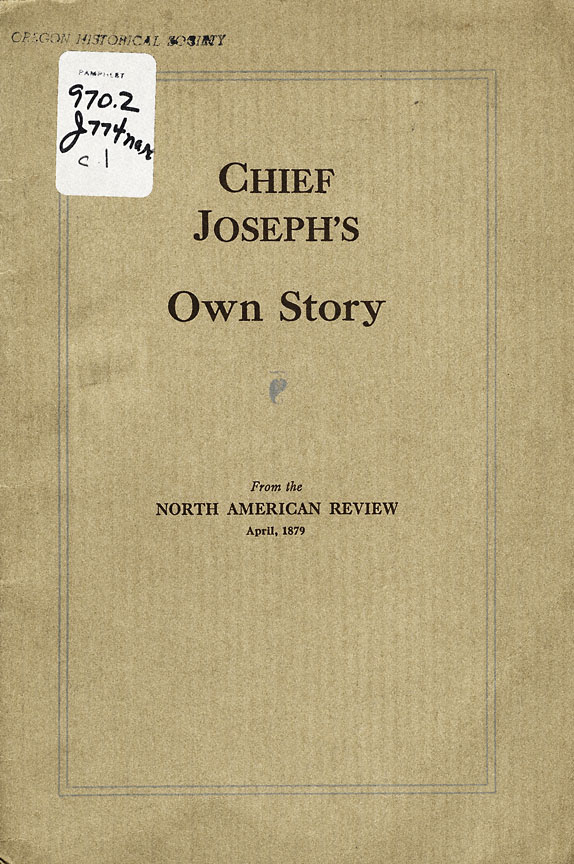- Catalog No. —
- PAM 970.2 J774nar
- Date —
- April 1879
- Era —
- 1846-1880 (Treaties, Civil War, and Immigration)
- Themes —
- Arts, Exploration and Explorers, Native Americans, Oregon Trail and Resettlement
- Credits —
- Oregon Historical Society Folklife Program
- Regions —
- Columbia River Oregon Country
- Author —
- Chief Joseph
Chief Joseph's Own Story
This excerpt is from a pamphlet titled “Chief Joseph’s Story,” a reprint of a speech which was transcribed and published in the April 1879 edition of the North American Review.
In this excerpt, In-mut-too-yah-lat-lat (1841-1904)—better known as Chief Joseph—relates the story of the first encounters between the Nimi’ipuu and Euro Americans. He says that the first whites his people met were French Canadian fur traders, who gave his people the name by which they are most commonly known, Nez Perce (they often refer to themselves as the Nimi’ipuu, which means “the real people”). He notes that the fur traders were less than completely honest and that the Nez Perce were “divided in opinion about these men.”
Nevertheless, when a band of American explorers straggled into a Nez Perce camp in September 1805, the Indians received the strangers kindly, giving them, as Chief Joseph notes, “a great feast, as a proof that their hearts were friendly.” The Corps of Discovery, led by Captains Meriwether Lewis and William Clark, were delighted with the offering of food, having undergone three weeks of hard travel through rugged mountains. Unfortunately, the explorers were unaccustomed to Nez Perce cuisine, which made many of them violently ill.
The Nimi’ipuu proved to be key allies of the Corps of Discovery. In addition to providing relief to the hungry explorers, the Nez Perce traded with the Americans and took care of their horses in the fall and winter of 1805-1806. Two Nez Perce chiefs also accompanied the Corps on their journey down the Snake and Columbia rivers, serving as intermediaries between the explorers and other Sahaptin-speaking Indians.
Chief Joseph goes on to describe the Nez Perce relationship with the Spauldings, who were among the first missionaries to work in the Pacific Northwest. He also discusses the 1855 Walla Walla council, noting that his father—also known as Joseph—refused to participate. In 1877, the U.S. Army forced Chief Joseph’s band out of their homeland in the Wallowa Valley in a campaign known as the Nez Perce War. After several years of exile in Kansas and Oklahoma, Chief Joseph and most of his people relocated to the Colville Reservation in north central Washington.
Further Reading:
Chief Joseph. “An Indian’s View of Indian Affairs.” North American Review 128 (April 1879): 412-433.
Josephy, Alvin M. The Nez Perce Indians and the Opening of the Northwest. New Haven: Yale University Press, 1965.
Written by Cain Allen, © Oregon Historical Society, 2004
